If you've never heard of the Akbash, don't feel bad. This is a very rare breed and not very well known outside of Turkey. According to Akbash websites, the name is pronounced Ah-k-bah-sh and that the name is a derivative of a Turkish word meaning "white head". Other names for the Akbash over the years have been the Akbas and the Coban Kopengi.
General Appearance
An Akbash would be a nightmare to anyone living with all-black furniture or all-black drapes. They are entirely white dogs, although sometimes the white looks more like cream or ivory. Often, their ears will be a darker color than the rest of the body. Their noses are black or pink. They were bred to be white in order to make them blend in with the flocks that they guarded. Its thought that they breed may have first come into existence 3000 years ago.
An Akbash is big, solid dog, weighting up to 130 pounds (although just a mere 100 pounds is more the average). At the shoulder, they can be as tall as 32 inches, but average about 28 inches tall. They have a large, Mastiff-type head and floppy ears, similar to a Labrador's. They have a long, gently curving tail.
Their coats can vary in length and thickness, depending on the individual dog. Mostly, they are slightly shaggy, but aficionados not that they do not have the "doggy odor" characteristic of other breeds. Also, for such a big dog, they move smoothly and lightly. Bitches often look noticeable feminine in comparison to a fully mature, fully intact male.
Strengths and Weaknesses
Akbash dogs are highly intelligent, affectionate and easily bored. They need regular exercise and interaction with their people. If you don't mind being rounded up like a sheep every now and then, he could make a loyal and goofy companion. These dogs need a lot of room and so are not recommended for apartment life.
Akbash dogs can work with a variety of livestock and not just sheep or goats. They have also worked with geese, ducks, cattle, exotic birds, deer, llamas, alpacas and children.
Unfortunately, Akbash dogs do not generally get along with other dogs, although they are trainable to accept other dogs. Also, being such large dogs, an Akbash is prone to health disorders common to all very large breeds, such as bloat and hip dysplasia, although there are breeders who will not breed a dog with hip dysplasia, which can only serve to help the entire breed.
Image from Wikimedia Commons

.jpg)



